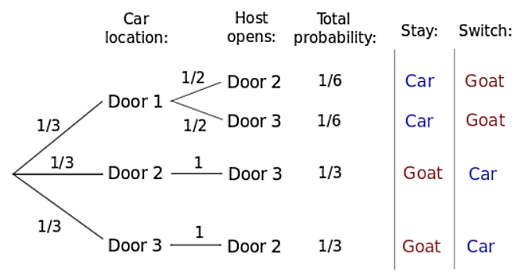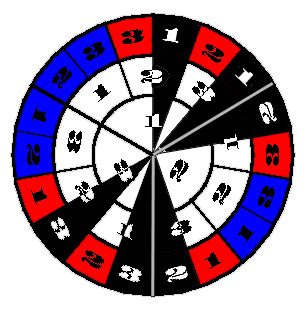
Monty Haul was the host of Let’s Make a Deal, a TV show that inspired the following problem:
However, after you choose a door, the host opens another one and reveals a goat (he knows where the car is so he can always do this; if both other doors have goats he picks one at random). He then asks if you want to change doors.
Should you switch or not?
The answer is yes: there is a 2/3 chance that by changing doors you will win the game, and just 1/3 if you stay with your original choice.
This can feel very counterinutive. Surely if there are two possibilities, there is a 50% chance of either one?
Here are a few different ways to look at the problem.
This diagram is from the Wikipedia entry. It assumes the contestant chose door number 1.

There are four possibilities, but they do not have the same probability:
In the first two cases, where the car is behind door 1, the contestant wins by staying; but the probability is only 1/6 + 1/6 = 1/3.
In the last two cases, where the car is not behind door 1, the contestant wins by switching. The probability is 1/3 + 1/3 = 2/3.
Another way to visualise the problem space is to draw it as a kind of roulette wheel (from this page).

To paraphrase that page: when the car’s door is not chosen (which happens 2/3 of the time), the host effectively tells the contestant where the car is.
If the problem is altered so that the host picks a door at random (other than the contestant’s door), and if he accidentally reveals the car then it doesn’t count and they start again from scratch, the diagram changes:

The “start again” states are marked in black. Now there are an equal number of red and blue sections (6 each), so the probability of winning by staying or switching becomes 1/2 in both cases.
This alternate version is sometimes called the Monty Fall problem: the host falls and accidentally opens a door at random.
Some things to notice:
It may seem a little paradoxical that the Monty Hall and Monty Fall problems have different answers, since the actions look the same in both versions: the contestant chooses a door, then the host opens a door revealing a goat. But having 1/3 of the games cancelled makes a difference to the probabilites.
Inspired by user “Schenck” on the Understanding the Monty Hall problem page:
Another way to look at it: after Monty discards a non-Ace, the 2/3 probability that was previously distributed between his two cards now applies just to his remaining card.
If the idea of probabilities being redistributed sounds odd, read on.
Imagine each door having a cup in front of it with an amount of water representing the probability of having the car. The cups start with 1/3 litre each.
Call the doors A, B and C. The contestant picks door A.
The host opens door B, revealing a goat. Now we know that the probability of door B having the car is 0, so we should empty out cup B – but where does the water go?
The critical thing to remember is that when the host decided which door to open, he was only choosing between doors B and C. Door A is not considered because of the rules of the game (he can’t open the door that the contestant chose). As Joel Thomas says: “Your initial decision locks one of the doors ... It’s not the door that opens, it’s the door you’re keeping closed that makes the difference.”
By opening door B, the host is effectively saying: “Between B and C, the only possibility is C.” We are given no new information about door A at all, only information about the relative probability between B and C, so A’s probability does not change.
So all of B’s water is poured into cup C, which now holds 2/3 litre. The contestant should change to door C, since it has the highest probability of having the car.
If you extended the Monty Hall problem to 100 doors instead of 3, with the host opening one door at a time to reveal goats behind all but one of them (other than the contestant’s door), then each cup of water for the opened doors gets evenly distributed between the cups of all the remaining closed doors except for the contestant’s one.
At the end (after 98 doors have been opened), the cup for the contestant’s door contains 1/100 litre, and the cup for the other remaining closed door contains 99/100 litre – the “concentrated probability” from all of the previously opened doors.
(Or think of it in terms of the card game analogy: Monty takes 99 cards then discards 98 non-Aces).
But even if only a single door was opened, the contestant would still be better off switching to any other door, since the amount of water in front of it would be greater than 1/100 litre (1/100 + 1/9800 = about 0.0101 litres).
From user “Ted” on the Understanding the Monty Hall problem page:
Here’s another way to look at it: suppose after you pick one door, Monty offers to let you trade it for BOTH the other two doors ... Clearly you should should take the trade; your odds are twice as good with two doors. Well that’s the deal that Monty is offering in the problem except that he’s showing which of the other two doors has a goat (since at least one of them must have a goat behind it).
You’re essentially trading for both doors, but you know ahead of time what’s behind one of them. Whether he opens one of those two doors you traded for ahead of time or after the fact makes no difference – you should trade for the two doors to double your odds.
From user “Dinesh” on the Understanding the Monty Hall problem page:
There are three possible scenarios. Assume that out of A, B & C (A has car):
1. You pick A - you lose by shifting.
2. You pick B - you win by shifting.
3. You pick C - you win by shifting.
So you have 2 out of 3 chances of winning by shifting.
Perhaps the most direct way to explore the Monty Haul problem is to simulate it. There are plenty of simulators online, such as this one and one near the top of the understanding the Monty Hall problem page.
Alternatively, you can use three dice. If you happen to have some 3-sided dice (they do exist!), perfect. Otherwise use standard dice and subtract 3 when a value higher than 3 comes up (so 4 => 1, 5 => 2, 6 => 3).
Choose a strategy to use for the whole game (switch or stay), then do the following a large number of times:
The observant reader might notice something. When the strategy is stay, the problem reduces to: “If you roll two three sided dice, what is the probability that they are both the same number?” and the unopened door (D3) is irrelevant.
Which is another way of saying, the stay strategy succeeds 1/3 of the time, just as it would if the host never opened a door.
If the 2/3 result still feels wrong somehow, you are not alone. When Marilyn vos Savant (highest recorded IQ 1986-89 according to the Guinness Book of Records) responded to a question about the Monty Hall problem in a magazine in 1990, saying that the contestant should switch, she received thousands of letters claiming that her reasoning was flawed.
Harvard University Professor Persi Diaconis says there is no disgrace in getting this one wrong: “Our brains are just not wired to do probability problems very well.”
Here are some ways our intuition about probability can work against us.
All things being equal
People have a tendency to assign equal values to multiple unknown probabilities. Once one of the doors is opened, it feels automatic to assign the remaining doors a probability of 1/2 each. In other circumstances this might be correct, but more is going on in the Monty Hall problem than simply excluding an option.
A similar thing can happen when someone enumerates all the possibilities in a problem. If there are four basic outcomes, it feels natural to assign them a probability of 1/4 each. But this is not always justified, as seen in the decision tree for this problem.
Significance of changes
It can be easy to miss the significance of seemingly minor changes to a problem. The outcome is different if you change the set up of Monty Hall:
Information gained
The Monty Hall problem hinges on the fact that the host chooses between two doors to open, not all three. As explained under cups of water, no new information is gained about the contestant’s door when the goat door is revealed, so the probability associated with his door remains unchanged.
This is very easy to miss; choosing from two doors and opening one to reveal a goat looks a lot like choosing from three doors to reveal a goat. But the information gained in each case is different.
I think the most helpful analogy is a version of the card game with 100 cards. When Monty discards 98 non-Ace cards from his hand, he is only giving information about his own cards: if he has an Ace at all, it must be his last remaining card. If he revealed his cards at random, or he was allowed to reveal your card, then the probabilities would be different since the Ace would be involved. But since the Ace is guaranteed not to be revealed, there is no new information about whether you are holding it, so your probability remains at 1% for the whole game.
Not set in stone
Even when the correct answer is reached the reasoning can still be flawed. When explaining why the probability associated with the contestant’s door doesn’t change, some people use a statement like the following: “Once the player selects a door, the probability is set in stone.”
As Sasha Volkov writes: “Any explanation that says something like ‘The probability of door 1 was 1/3, and nothing can change that...’ is automatically fishy: probabilities are expressions of our ignorance about the world, and new information can change the extent of our ignorance.”
Probabilities can change, be redistributed or set to 0% or 100% as information gets updated. The tricky part is keeping track of exactly what we know at each stage.
Top –
Maths –
Home
Questions or comments to:
[email protected]